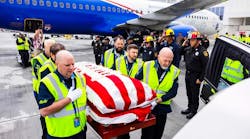Whether you’re a frequent flyer or have only flown a handful of times, it’s a safe bet that you’ve boarded a Boeing 757 at some point in your travels. Manufactured from the early 80s until the mid-2000s, Boeing built over 1,000 types of the aircraft for more than 50 airlines and private carriers – a few of which remain in service today. The fleet was used for both domestic and international flights, and was known for its Rolls-Royce or Pratt & Whitney turbofans that powered the aircraft to carry passengers, freight and cargo, and support military and governments operations.
The height of the B757s glory was in the late 90s and early 2000s, when aircraft activity peaked around 1 million scheduled flights planned in 2000. At that time, nearly every major U.S. carrier had a large fleet for both domestic and international markets, and the aircraft was widely used throughout most of the world. In fact, the only area where the airplane never really gained traction was Africa, where in the peak year of 2000, the continent accounted for less than one percent of all flights.
The B757 in Today’s Travel Market
While 2000 might have been the height of B757 flights, you can still find the aircraft servicing a handful of North American, European and transatlantic routes today. Looking at the provided table, 2011 was the peak year for Europe to United States B757 service within the last eight years, but the number of airlines operating routes has actually increased since then. Why?
Though many of the aircrafts have been taken out of the skies, a look at recent trends reveals the B757 is still used to support new and existing routes to and from major U.S. and European hub airports. The airlines using this aircraft today include American, Delta and United.
As transatlantic travel continues to increase in popularity, major U.S. carriers have adopted B757s to supplement developing and established routes to some of Europe’s largest airports, including Frankfurt, London Heathrow and Paris Charles De Gaulle. A more specific example is Dublin, where seven markets will be serviced by B757s in 2017 compared to only three in 2011.
The fleet also plays an important role in the fight for market share between LCCs vs. legacy carriers. Competition between legacy carriers remains high, and as passengers increasingly flock toward low-cost airlines, B757s play a useful role balancing for legacy carriers, providing both supplemental capacity on trunk routes and operating the thinner secondary hub markets.
Where is the B757 now?
United Airlines’ announcement that they are ceasing some operations to secondary European cities highlights the challenge of long-haul services. And while that change will have an impact on the B757s, it doesn’t signal the demise of the fleet.
Usage of the B757s fleet has certainly dropped from its peak, as there are 315,503 scheduled flights planned in 2017, down roughly 70 percent from the year 2000. As the largest North American operator of the aircraft, Delta Air Lines has just under 110,000 flights scheduled in 2017, down 44 percent compared to 2011. According to CAPA, the airline currently has around 126 of the aircraft type in operation.
Still, the B757 remains an integral aircraft in many regions in the world, and won’t be out of the skies for quite a while. North America remains the major region of use for the aircraft, and will account for over 62 percent of total planned flights this year. Comparatively speaking, in 2000, North America held 64 percent of all B757 flights. Collectively, Western Europe and North America have 82 percent of the aircraft planned services in 2017, a similar proportion to that of 2000.
Ultimately, the B757 isn’t too out-of-date for today’s transatlantic market, despite the role the aircraft played in expanding hub airport connectivity of mainline U.S. airlines to other major European markets. The continued growth of low-cost airlines in both primary and secondary markets is, to an extent, rerouting the B757 back to its core operations. The end result: the aircraft will maintain its critical role in the aviation marketplace – supplementing airline and airport growth and bringing passengers to their next destination.
John is a senior analyst at air travel intelligence company OAG. One of the most respected aviation experts in the industry, John’s analysis has been featured in major publications including The New York Times, CNN, USA Today, BBC, the Financial Times, TIME and more. John captures and analyzes complex aviation data and industry trends to provide commentary on what’s driving changes in the travel market. He’s served as a featured speaker at major industry events including the CAPA Americas Aviation Summit, the CAPA World Aviation Summit, the Routesonline Strategy Summit and more.




